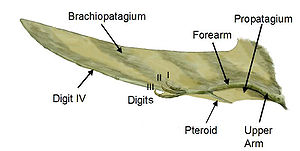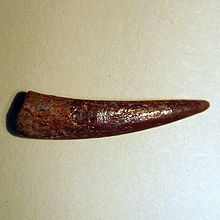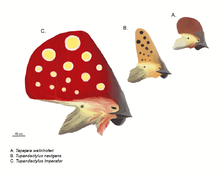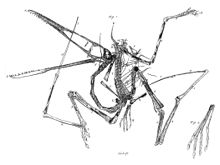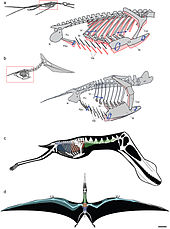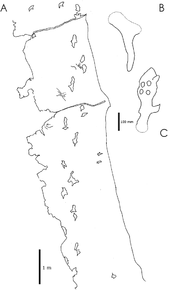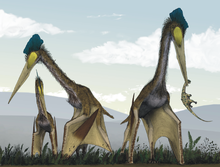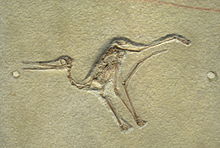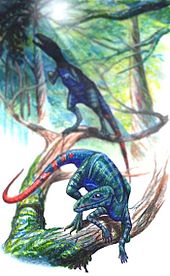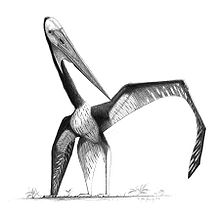
Pterosaur
Background Information
SOS Children, which runs nearly 200 sos schools in the developing world, organised this selection. Child sponsorship helps children one by one http://www.sponsor-a-child.org.uk/.
| Pterosaurs Temporal range: Late Triassic– Late Cretaceous, 210–65.5Ma |
|
|---|---|
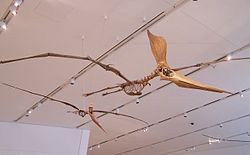 |
|
| Replica Geosternbergia sternbergi skeletons, female (left) and male (right) | |
| Scientific classification |
|
| Kingdom: | Animalia |
| Phylum: | Chordata |
| Class: | Reptilia |
| Clade: | Ornithodira |
| Order: | †Pterosauria Kaup, 1834 |
| Suborders | |
|
† Pterodactyloidea |
|
| Synonyms | |
|
|
Pterosaurs (pron.: / ˈ t ɛr ɵ s ɔr /, from the Greek πτερόσαυρος, pterosauros, meaning "winged lizard") were flying reptiles of the clade or order Pterosauria. They existed from the late Triassic to the end of the Cretaceous Period (220 to 65 million years ago). Pterosaurs are the earliest vertebrates known to have evolved powered flight. Their wings were formed by a membrane of skin, muscle, and other tissues stretching from the ankles to a dramatically lengthened fourth finger. Early species had long, fully toothed jaws and long tails, while later forms had a highly reduced tail, and some lacked teeth. Many sported furry coats made up of hair-like filaments known as pycnofibres, which covered their bodies and parts of their wings. Pterosaurs spanned a wide range of adult sizes, from the very small Nemicolopterus to the largest known flying creatures of all time, including Quetzalcoatlus and Hatzegopteryx.
Pterosaurs are often referred to in the popular media and by the general public as flying dinosaurs, but this is incorrect. The term "dinosaur" is properly restricted to only those reptiles descended from the last common ancestor of the groups Saurischia and Ornithischia (clade Dinosauria, which includes birds), and current scientific consensus is that this group excludes the pterosaurs, as well as the various groups of extinct marine reptiles, such as ichthyosaurs, plesiosaurs, and mosasaurs. Pterosaurs are also incorrectly referred to as pterodactyls, particularly by journalists. "Pterodactyl" refers specifically to members of the genus Pterodactylus, and more broadly to members of the suborder Pterodactyloidea.
Description
The anatomy of pterosaurs was highly modified from their reptilian ancestors for the demands of flight. Pterosaur bones were hollow and air-filled, like the bones of birds. They had a keeled breastbone that was developed for the attachment of flight muscles and an enlarged brain that shows specialised features associated with flight. In some later pterosaurs, the backbone over the shoulders fused into a structure known as a notarium, which served to stiffen the torso during flight, and provide a stable support for the scapula (shoulder blade).
Wings
Pterosaur wings were formed by membranes of skin and other tissues. The primary membranes attached to the extremely long fourth finger of each arm and extended along the sides of the body to the ankles.
While historically thought of as simple, leathery structures composed of skin, research has since shown that the wing membranes of pterosaurs were actually highly complex and dynamic structures suited to an active style of flight. The outer wings (from the tip to the elbow) were strengthened by closely spaced fibers called actinofibrils. The actinofibrils themselves consisted of three distinct layers in the wing, forming a crisscross pattern when superimposed on one another. The actual function of the actinofibrils is unknown, as is the exact material from which they were made. Depending on their exact composition (keratin, muscle, elastic structures, etc.), they may have been stiffening or strengthening agents in the outer part of the wing. The wing membranes also contained a thin layer of muscle, fibrous tissue, and a unique, complex circulatory system of looping blood vessels.
As evidenced by hollow cavities in the wing bones of larger species and soft tissue preserved in at least one specimen, some pterosaurs extended their system of respiratory air sacs (see Paleobiology section below) into the wing membrane itself.
Parts of the pterosaur wing
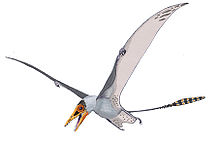
The pterosaur wing membrane is divided into three basic units. The first, called the propatagium ("first membrane"), was the forward-most part of the wing and attached between the wrist and shoulder, creating the "leading edge" during flight. This membrane may have incorporated the first three fingers of the hand, as evidenced in some specimens. The brachiopatagium ("arm membrane") was the primary component of the wing, stretching from the highly elongated fourth finger of the hand to the hind limbs (though where exactly on the hind limbs it anchored is controversial and may have varied between species, see below). Finally, at least some pterosaur groups had a membrane that stretched between the legs, possibly connecting to or incorporating the tail, called the uropatagium; the extent of this membrane isn't certain, as studies on Sordes seem to suggest that it simply connected the legs but did not involve the tail (rendering it a cruropatagium). It is generally agreed though that non-pterodactyloid pterosaurs had a broader uro/cruropatagium, with pterodactyloids only having membranes running along the legs; Pteranodon in particular might have developed/redeveloped an uropatagium, given the structure of the tail.
A bone unique to pterosaurs, known as the pteroid, connected to the wrist and helped to support a forward membrane (the propatagium) between the wrist and shoulder. Evidence of webbing between the three free fingers of the pterosaur forelimb suggests that this forward membrane may have been more extensive than the simple pteroid-to-shoulder connection traditionally depicted in life restorations. The position of the pteroid bone itself has been controversial. Some scientists, notably Matthew Wilkinson, have argued that the pteroid pointed forward, extending the forward membrane. However, this view was strongly refuted in a 2007 paper by Chris Bennett, who showed that the pteroid did not articulate as previously thought and could not have pointed forward, but rather inward toward the body as traditionally thought.
Three lines of evidence, morphological, developmental and histological, indicate that the pteroid is a true bone, rather than ossified cartilage. The origin of the pteroid is unclear: it may be a modified carpal, the first metacarpal, or a neomorph (new bone).
The pterosaur wrist consists of two inner (proximal) and four outer (distal) carpals (wrist bones), excluding the pteroid bone, which may itself be a modified distal carpal. The proximal carpals are fused together into a "syncarpal" in mature specimens, while three of the distal carpals fuse to form a distal syncarpal. The remaining distal carpal, referred to here as the medial carpal, but which has also been termed the distal lateral, or pre-axial carpal, articulates on a vertically elongate biconvex facet on the anterior surface of the distal syncarpal. The medial carpal bears a deep concave fovea that opens anteriorly, ventrally and somewhat medially, within which the pteroid articulates.
There has been considerable argument among paleontologists about whether the main wing membranes (brachiopatagia) attached to the hind limbs, and if so, where. Fossils of the rhamphorhynchoid Sordes, the anurognathid Jeholopterus, and a pterodactyloid from the Santana Formation seem to demonstrate that the wing membrane did attach to the hindlimbs, at least in some species. However, modern bats and flying squirrels show considerable variation in the extent of their wing membranes and it is possible that, like these groups, different species of pterosaur had different wing designs. Indeed, analysis of pterosaur limb proportions shows that there was considerable variation, possibly reflecting a variety of wing-plans.
Many, if not all, pterosaurs also had webbed feet.
Skull, teeth and crests
Most pterosaur skulls had elongated jaws with a full complement of needle-like teeth. In some cases, fossilized keratinous beak tissue has been preserved, though in toothed forms, the beak is small and restricted to the jaw tips and does not involve the teeth. Some advanced beaked forms were toothless, such as the pteranodonts and azhdarchids, and had larger, more extensive, and more bird-like beaks.
Unlike most archosaurs, which have several openings in the skull in front of the eyes, in pterodactyloid pterosaurs the antorbital opening and the nasal opening was merged into a single large opening, called the nasoantorbital fenestra. This likely evolved as a weight-saving feature to lighten the skull for flight.
Pterosaurs are well known for their often elaborate crests. The first and perhaps best known of these is the distinctive backward-pointing crest of some Pteranodon species, though a few pterosaurs, such as the tapejarids and Nyctosaurus sported incredibly large crests that often incorporated keratinous or other soft tissue extensions of the bony crest base.
Since the 1990s, new discoveries and more thorough study of old specimens have shown that crests are far more widespread among pterosaurs than previously thought, due mainly to the fact that they were frequently extended by or composed completely of keratin, which does not fossilize as often as bone. In the cases of pterosaurs like Pterorhynchus and Pterodactylus, the true extent of these crests has only been uncovered using ultraviolet photography. The discovery of Pterorynchus and Austriadactylus, both crested " rhamphorhynchoids", showed that even primitive pterosaurs had crests (previously, crests were thought to be restricted to the more advanced pterodactyloids).
Pycnofibres
At least some pterosaurs were covered with hair-like filaments known as pycnofibres, similar to but not homologous (sharing a common structure) with mammalian hair. Pycnofibres were not true hair as seen in mammals, but a unique structure that developed a similar appearance through convergent evolution. Although in some cases actinofibrils (internal structural fibres) in the wing membrane have been mistaken for pycnofibres or true hair, some fossils such as those of Sordes pilosus (which translates as "hairy demon") and Jeholopterus ninchengensis do show the unmistakable imprints of pycnofibres on the head and body, not unlike modern-day bats, another example of convergent evolution. It is unknown if they may be homologous with feathers. The presence of pycnofibres (and the demands of flight) imply that pterosaurs were endothermic (warm-blooded).
The term "pycnofibre", meaning "dense filament", was first coined in a paper on the soft tissue impressions of Jeholopterus by palaeontologist Alexander W.A. Kellner and colleagues in 2009.
History of discovery
The first pterosaur fossil was described by the Italian naturalist Cosimo Collini in 1784. Collini misinterpreted his specimen as a seagoing creature that used its long front limbs as paddles. A few scientists continued to support the aquatic interpretation even until 1830, when the German zoologist Johann Georg Wagler suggested that Pterodactylus used its wings as flippers. Georges Cuvier first suggested that pterosaurs were flying creatures in 1801, and coined the name "Ptero-dactyle" in 1809 for the specimen recovered in Germany. However, due to the standardization of scientific names, the official name for this genus became Pterodactylus, though the name "pterodactyl" continued to be popularly and incorrectly applied to all members of Pterosauria. Paleontologists now avoid using "pterodactyl" and prefer the term "pterosaur". They relegate the term "pterodactyl" specifically for members of the genus Pterodactylus or more broadly for members of the suborder Pterodactyloidea.
Paleobiology
Flight
The mechanics of pterosaur flight are not completely understood or modeled at this time.
Katsufumi Sato, a Japanese scientist, did calculations using modern birds and decided that it was impossible for a pterosaur to stay aloft. In the book Posture, Locomotion, and Paleoecology of Pterosaurs it is theorized that they were able to fly due to the oxygen-rich, dense atmosphere of the Late Cretaceous period. However, one must note both Katsufumi and the authors of Posture, Locomotion, and Paleoecology of Pterosaurs based their research on the now outdated theories of pterosaurs being seabird-like, and the size limit doesn't apply to terrestrial pterosaurs like azhdarchids and tapejarids Furthermore, Darren Naish concluded that atmospheric differences between the present and the Mesozoic weren't needed for the giant size of pterosaurs.
However, Mark Witton and Mike Habib, of the University of Portsmouth and Johns Hopkins University respectively, argued that pterosaurs used a vaulting mechanism to obtain flight. Once in air, pterosaurs could reach speeds up to 120 kilometres per hour (75 mph) and travel thousands of kilometres.
In 1985, the Smithsonian Institution commissioned aeronautical engineer Paul MacCready to build a half-scale working model of Quetzalcoatlus northropi. The replica was launched with a ground-based winch. It flew several times in 1986 and was filmed as part of the Smithsonian's IMAX film On the Wing. However, the model was not anatomically correct and embodied vertical and horizontal tail stabilizers that were lacking in pterosaurs. The weight distribution of the model was also different due to the longer tail of the model.
Air sacs and respiration
A 2009 study showed that pterosaurs had a lung-air sac system and a precisely controlled skeletal breathing pump, which supports a flow-through pulmonary ventilation model in pterosaurs, analogous to that of birds. The presence of a subcutaneous air sac system in at least some pterodactyloids would have further reduced the density of the living animal.
Nervous system
A study of pterosaur brain cavities using X-rays revealed that the animals (Rhamphorhynchus muensteri and Anhanguera santanae) had massive flocculi. The flocculus is a brain region that integrates signals from joints, muscles, skin and balance organs.
The pterosaurs' flocculi occupied 7.5% of the animals' total brain mass, more than in any other vertebrate. Birds have unusually large flocculi compared with other animals, but these only occupy between 1 and 2% of total brain mass.
The flocculus sends out neural signals that produce small, automatic movements in the eye muscles. These keep the image on an animal's retina steady. Pterosaurs may have had such a large flocculus because of their large wing size, which would mean that there was a great deal more sensory information to process.
Ground movement
Pterosaurs' hip sockets are oriented facing slightly upwards, and the head of the femur (thigh bone) is only moderately inward facing, suggesting that pterosaurs had a semi-erect stance. It would have been possible to lift the thigh into a horizontal position during flight as gliding lizards do.
There was considerable debate whether pterosaurs ambulated as quadrupeds or as bipeds. In the 1980s, paleontologist Kevin Padian suggested that smaller pterosaurs with longer hindlimbs such as Dimorphodon might have walked or even run bipedally, in addition to flying, like road runners. However, a large number of pterosaur trackways were later found with a distinctive four-toed hind foot and three-toed front foot; these are the unmistakable prints of pterosaurs walking on all fours.
Unlike most vertebrates, which walk on their toes with ankles held off the ground ( digitigrade), fossil footprints show that pterosaurs stood with the entire foot in contact with the ground ( plantigrade), in a manner similar to humans and bears. Footprints from azhdarchids show that at least some pterosaurs walked with an erect, rather than sprawling, posture.
Though traditionally depicted as ungainly and awkward when on the ground, the anatomy of at least some pterosaurs (particularly pterodactyloids) suggests that they were competent walkers and runners. The forelimb bones of azhdarchids and ornithocheirids were unusually long compared to other pterosaurs, and in azhdarchids, the bones of the arm and hand (metacarpals) were particularly elongated. Furthermore, azhdarchid front limbs as a whole were proportioned similarly to fast-running ungulate mammals. Their hind limbs, on the other hand, were not built for speed, but they were long compared with most pterosaurs, and allowed for a long stride length. While azhdarchid pterosaurs probably could not run, they would have been relatively fast and energy efficient.
The relative size of the hands and feet in pterosaurs (by comparison with modern animals such as birds) may indicate what type of lifestyle pterosaurs led on the ground. Azhdarchid pterosaurs had relatively small feet compared to their body size and leg length, with foot length only about 25%-30% the length of the lower leg. This suggests that azhdarchids were better adapted to walking on dry, relatively solid ground. Pteranodon had slightly larger feet (47% the length of the tibia), while filter-feeding pterosaurs like the ctenochasmatoids had very large feet (69% of tibial length in Pterodactylus, 84% in Pterodaustro), adapted to walking in soft muddy soil, similar to modern wading birds.
Natural predators
Pterosaurs are known to have been eaten by theropods. In the 1 July 2004 edition of Nature, paleontologist Eric Buffetaut discusses an early Cretaceous fossil of three cervical vertebrae of a pterosaur with the broken tooth of a spinosaur embedded in it. The vertebrae are known not to have been eaten and exposed to digestion, as the joints still articulated.
Reproduction and life history
Very little is known about pterosaur reproduction, and pterosaur eggs are very rare. The first known pterosaur egg was found in the quarries of Liaoning, the same place that yielded the famous 'feathered' dinosaurs. The egg was squashed flat with no signs of cracking, so evidently the eggs had leathery shells, as in modern lizards. This was supported by the description of an additional pterosaur egg belonging to the genus Darwinopterus, described in 2011, which also had a leathery shell and, also like modern reptiles but unlike birds, was fairly small compared to the size of the mother. A study of pterosaur eggshell structure and chemistry published in 2007 indicated that it is likely pterosaurs buried their eggs, like modern crocodiles and turtles. Egg-burying would have been beneficial to the early evolution of pterosaurs, as it allows for more weight-reducing adaptations, but this method of reproduction also would have put limits on the variety of environments pterosaurs could live in, and may have disadvantaged them when they began to face ecological competition from birds.
Wing membranes preserved in pterosaur embryos are well developed, suggesting pterosaurs were ready to fly soon after birth. Fossils of pterosaurs only a few days to a week old (called flaplings) have been found, representing several pterosaur families, including pterodactylids, rhamphorhinchids, ctenochasmatids and azhdarchids. All preserve bones which show a relatively high degree of hardening (ossification) for their age, and wing proportions similar to adults. In fact, many pterosaur flaplings have been considered adults and placed in separate species in the past. Additionally, flaplings are normally found in the same sediments as adults and juveniles of the same species, such as the Pterodactylus and Rhamphorhynchus flaplings found in the Solnhofen limestone of Germany, and Pterodaustro flaplings from Brazil. All are found in deep aquatic environment far from shore.
It is not known whether pterosaurs practiced any form of parental care, but their ability to fly as soon as they emerged from the egg and the numerous flaplings found in environments far from nests and alongside adults has led most researchers, including Christopher Bennett and David Unwin, to conclude that the young were dependent on their parents for a relatively short period of time, during a period of rapid growth while the wings grew long enough to fly, and then left the nest to fend for themselves, possibly within days of hatching. Alternatively, they may have used stored yolk products for nourishment during their first few days of life, as in modern reptiles, rather than depend on parents for food.
Growth rates of pterosaurs once they hatched varied across different groups. In more primitive, long-tailed pterosaurs (" rhamphorhynchoids") such as Rhamphorhynchus, the average growth rate during the first year of life was 130% to 173%, slightly faster than the growth rate of alligators. Growth in these species slowed after sexual maturity, and it would have taken more than three years for Rhamphorhynchus to attain maximum size. In contrast, the more advanced, large pterodactyloid pterosaurs such as Pteranodon grew to adult size within the first year of life. Additionally, pterodactyloids had determinate growth, meaning that the animals reached a fixed maximum adult size and stopped growing.
Daily activity patterns
Comparisons between the scleral rings of pterosaurs and modern birds and reptiles have been used to infer daily activity patterns of pterosaurs. The pterosaur genera Pterodactylus, Scaphognathus, and Tupuxuara have been inferred to be diurnal, Ctenochasma, Pterodaustro, and Rhamphorhynchus have been inferred to be nocturnal, and Tapejara has been inferred to be cathemeral, being active throughout the day for short intervals. As a result, the possibly fish-eating Ctenochasma and Rhamphorhynchus may have had similar activity patterns to modern nocturnal seabirds, and the filter-feeding Pterodaustro may have had similar activity patterns to modern anseriform birds that feed at night. The differences between activity patterns of the Solnhofen pterosaurs Ctenochasma, Rhamphorhynchus, Scaphognathus, and Pterodactylus may also indicate niche partitioning between these genera.
Evolution and extinction
Origins
Because pterosaur anatomy has been so heavily modified for flight, and immediate "missing link" predecessors have not so far been described, the ancestry of pterosaurs is not well understood. Several hypotheses have been advanced, including links to ornithodirans like Scleromochlus, an ancestry among the basal archosauriforms like Euparkeria, or among the prolacertiformes (which include gliding forms like Sharovipteryx).
Two researchers, Chris Bennett (1996) and David Peters (2000), have found pterosaurs to be prolacertiformes or closely related to them. Peters uses a technique called DGS, which involves applying the digital tracing features of photo editing software to images of pterosaur fossils. Bennett only recovered pterosaurs as close relatives of the prolacertiformes after removing characteristics of the hind limb from his analysis, in an attempt to test the idea that these characters are the result of convergent evolution between pterosaurs and dinosaurs. However, subsequent analysis by Dave Hone and Michael Benton (2007) could not reproduce this result. Hone and Benton found pterosaurs to be closely related to dinosaurs even without hind limb characters. They also criticized previous studies by David Peters, raising questions about whether conclusions reached without access to the primary evidence, that is, the extant pterosaur fossils, can be held to have the same weight as conclusions based strictly on first-hand interpretation. Peters maintains that DGS is superior to on-sight and first-hand interpretation. Hone and Benton concluded that although more primitive pterosauromorphs are needed to clarify their relationships, pterosaurs are best considered archosaurs, and specifically ornithodirans, given current evidence. In Hone and Benton's analysis, pterosaurs are either the sister group of Scleromochlus or fall between it and Lagosuchus on the ornithodiran family tree. Sterling Nesbitt (2011) found strong support for a clade composed of Scleromochlus and pterosaurs.
Classification
Classification of pterosaurs has historically been difficult, because there were many gaps in the fossil record. Many new discoveries are now filling in these gaps and giving a better picture of the evolution of pterosaurs. Traditionally, they are organized into two suborders:
- Rhamphorhynchoidea (Plieninger, 1901): A group of early, basal ("primitive") pterosaurs, many of which had long tails and short metacarpal bones in the wing. They appeared in the Late Triassic period, and lasted until the late Jurassic. Rhamphorhynchoidea is a paraphyletic group (since the pterodactyloids evolved directly from them and not from a common ancestor), so with the increasing use of cladistics it has fallen out of favour in most technical literature.
- Pterodactyloidea (Plieninger, 1901): The more derived ("advanced") pterosaurs, with short tails and long wing metacarpals. They appeared in the middle Jurassic period, and lasted until the Cretaceous–Paleogene extinction event wiped them out at the end of the Cretaceous.
Listing of families and superfamilies within Pterosauria, after Unwin 2006 unless otherwise noted.
- ORDER PTEROSAURIA (extinct)
- Suborder Rhamphorhynchoidea *
- Family Anurognathidae
- Family Campylognathoididae
- Family Dimorphodontidae
- Family Rhamphorhynchidae
- Suborder Pterodactyloidea
- Superfamily Ornithocheiroidea
- Family Istiodactylidae
- Family Nyctosauridae
- Family Ornithocheiridae
- Family Pteranodontidae
- Superfamily Ctenochasmatoidea
- Family Ctenochasmatidae
- Family Gallodactylidae
- Family Pterodactylidae
- Superfamily Dsungaripteroidea
- Family Dsungaripteridae
- Family Germanodactylidae
- Superfamily Azhdarchoidea
- Family Azhdarchidae
- Family Chaoyangopteridae
- Family Lonchodectidae
- Family Tapejaridae
- Superfamily Ornithocheiroidea
- Suborder Rhamphorhynchoidea *
The precise relationships between pterosaurs is still unsettled. However, several newer studies are beginning to make things clearer. Cladogram simplified after Unwin.
| Pterosauria |
|
||||||||||||||||||||||||||||||
|
|
| Pterodactyloidea |
|
||||||||||||||||||||||||||||||||||||||||||||||||||||||
|
|
Extinction
It was once thought that competition with early bird species might have resulted in the extinction of many of the pterosaurs. By the end of the Cretaceous, only large species of pterosaurs are known. The smaller species seem to have become extinct, their niche filled by birds. However, pterosaur decline (if actually present) seems unrelated to bird diversity. At the end of the Cretaceous period, the Cretaceous–Paleogene extinction event which wiped out all non-avian dinosaurs and most avian dinosaurs as well, and many other animals, seemed to also take the pterosaurs. Alternatively, some pterosaurs may have been specialised for an ocean-going lifestyle. Consequently, when the Cretaceous–Paleogene extinction event severely affected marine life that these pterosaurs fed on, they went extinct. However, forms like azhdarchids and istiodactylids were not marine in habits.
Recently, several new pterosaur taxa have been discovered dating to the Campanian/Maastrichtian, such as the ornithocheirids Piksi and " Ornithocheirus", possible pteranodontids and nyctosaurids, and a tapejarid. This suggests that late Cretaceous pterosaur faunas were far more diverse than previously thought, possibly not even having declined significantly from the early Cretaceous.
Well known genera
Examples of pterosaur genera include:
- Pteranodon was 1.8 metres (six ft) long, with a wingspan of 7.5 m (25 ft), and lived during the late Cretaceous period.
- Pterodactylus had a wingspan of 50–75 centimetres (20 to –30 inches), and lived during the late Jurassic on lake shores.
- Pterodaustro was a Cretaceous pterosaur from South America with a wingspan around 1.33 metres and with over 500 tall, narrow teeth, which were presumably used in filter-feeding, much like modern flamingos. Also like flamingos, this pterosaur's diet may have resulted in the animal having a pink hue. It was South America's first pterosaur find.
- Quetzalcoatlus had a wingspan of 10–11 metres (33–36 ft), and was among the largest flying animals ever. It lived during the late Cretaceous period.
- Ornithocheirus was a large pterosaur that lived worldwide during the Early Cretaceous around 130 MYA. Males of the genus had crests on their bill.
- Hatzegopteryx was the largest flying animal, as currently known to science. Although no complete fossil has been discovered, what little fossils paleontologists have found give the creature an estimated wingspan of at least 10 metres (33 ft)
- Rhamphorhynchus was a Jurassic pterosaur with a vane at the end of its tail, which may have acted to stabilise the tail in flight.
In popular culture
Pterosaurs have been a staple of popular culture for as long as their cousins the dinosaurs, though they are usually not featured as prominently in films, literature or other art. Additionally, while the depiction of dinosaurs in popular media has changed radically in response to advances in paleontology, a mainly outdated picture of pterosaurs has persisted since the mid 20th century.
While the generic term "pterodactyl" is often used to describe these creatures, the animals depicted frequently represent either Pteranodon or Rhamphorhynchus, or a fictionalized hybrid of the two. Many children's toys and cartoons feature "pterodactyls" with Pteranodon-like crests and long, Rhamphorhynchus-like tails and teeth, a combination that never existed in nature. However, at least one type of pterosaur did have at least the Pteranodon-like crest and teeth—for example, the Ludodactylus, a name that means "toy finger" for its resemblance to old, inaccurate children's toys. Also, some depictions of pterosaurs incorrectly identify them as "birds", when in real life they were flying reptiles, and birds are actually descended from theropod dinosaurs.
Pterosaurs were also used in fiction in Arthur Conan Doyle's 1912 novel The Lost World, and subsequent 1925 film adaptation. They have been used in a number of films and television programs since, including the 1933 film King Kong, and 1966's One Million Years B.C.. In the latter, animator Ray Harryhausen had to add inaccurate bat-like wing fingers to his stop motion models in order to keep the membranes from falling apart, though this particular error was common in art even before the film was made. Pterosaurs were mainly absent from notable film appearances until 2001, with Jurassic Park III. However, paleontologist Dave Hone has noted that even after the 40 intervening years, the pterosaurs in this film had not been significantly updated to reflect modern research. Among the errors he noted as persisting from the 1960s to the 2000s were teeth even in toothless species (the Jurassic Park III pterosaurs were intended to be Pteranodon, which translates as "toothless wing"), nesting behavior that was known to be inaccurate by 2001, and leathery wings, rather than the taut membranes of muscle fibre that was actually present and required for pterosaur flight.

